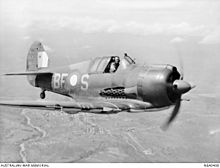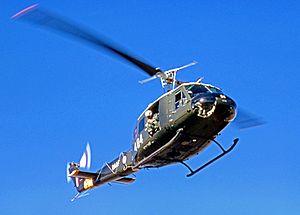No. 5 Squadron RAAF facts for kids
Quick facts for kids No. 5 Squadron RAAF |
|
|---|---|

A Boomerang aircraft operated by No. 5 Squadron in 1944
|
|
| Active | June 1917 – May 1919 April 1936 – December 1938 January 1941 – October 1946 May 1964 – December 1989 |
| Country | Australia |
| Branch | Royal Australian Air Force |
| Role | Training (1917–1919) Naval co-operation (1936–1938) Army co-operation (1941–1946) Utility helicopter (1964–1989) |
| Engagements | World War I World War II Indonesia-Malaysia Confrontation |
| Commanders | |
| Notable commanders |
Beau Palmer (1945) |
| Aircraft flown | |
| Fighter | Farman Shorthorn Airco DH.6 Avro 504 Sopwith Pup SE5a Sopwith Camel Sopwith Snipe CAC Wirraway CAC Boomerang P-40 Kittyhawk |
| Helicopter | UH-1 Iroquois AS350B Squirrel |
| Patrol | Supermarine Seagull |
No. 5 Squadron was a special unit of the Royal Australian Air Force (RAAF). Over its history, it had several important jobs. These included training pilots, working with the army, and flying helicopters.
The squadron first started in 1917. It was a training unit for the Australian Flying Corps in Britain. Its job was to get pilots ready to fly in World War I. Later, it became a squadron that worked with the navy. It was then renamed No. 9 Squadron RAAF.
During World War II, it was reformed to help the army. In the 1960s, it became a helicopter squadron. No. 5 Squadron was finally closed down in December 1989. Its role was taken over by the Australian Defence Force Helicopter Training School.
Contents
Squadron History
World War I and Between the Wars
No. 5 Squadron began on June 15, 1917, in Shawbury, England. It was part of the Australian Flying Corps. At first, it was called "29 (Australian) (Training) Squadron." This name was given by the Royal Flying Corps.
In August 1917, Major Henry Petre took command. By early 1918, its official name became "No. 5 (Training) Squadron, AFC." The squadron used many different types of planes. These included the Farman Shorthorn, Airco DH.6, Avro 504, Sopwith Pup, S.E.5a, and Sopwith Camel.
Its main job was to train Australian pilots in Britain during World War I. After training, pilots would join other fighting squadrons. The squadron trained about eight pilots each month. Experienced pilots from combat units helped with this training. No. 5 Squadron returned to Australia in May 1919. It was officially closed the next month.
On April 20, 1936, No. 5 Squadron started again. It was based at RAAF Base Richmond. This time, it was a naval fleet co-operation squadron. It used Supermarine Seagull V planes. These planes could land on water. They flew from Royal Australian Navy ships like cruisers. They also flew from the seaplane carrier HMAS Albatross. On January 1, 1939, No. 5 Squadron was renamed No. 9 Squadron RAAF.
World War II Service
No. 5 Squadron was reformed again on January 9, 1941. It was based at RAAF Base Laverton. This time, it was an army co-operation squadron. This meant it worked closely with ground troops. It flew Wirraway aircraft.
The squadron moved to Toowoomba in Queensland on May 17, 1942. It then moved to Toogoolawah and Kingaroy. In late 1943, it also started using Boomerang planes. These planes were partly designed in Australia.
On November 11, 1944, No. 5 Squadron went to Piva Airfield in Torokina. This was on Bougainville Island. They worked with New Zealand air force units. Their missions included looking for enemy forces (reconnaissance). They also helped guide artillery fire. They attacked enemy positions on the ground. Sometimes, they dropped supplies to Australian soldiers. The squadron also had small groups working on New Britain and New Guinea.
After the war ended in September 1945, the squadron received some P-40 Kittyhawk planes. But they still used Boomerangs and Wirraways. In early 1946, the squadron moved to Western Australia. The plan was to rebuild it there. However, No. 5 Squadron was closed down on October 18, 1946, at RAAF Base Pearce. During World War II, 24 members of the squadron sadly lost their lives.
Cold War Operations

No. 5 Squadron was reformed once more in 1964. This time, it became a helicopter squadron. It flew Bell UH-1 Iroquois helicopters. These helicopters were used for many different tasks. The squadron helped in operations against rebels on the Thai-Malay border. It also served during the Indonesia-Malaysia Confrontation.
On April 12, 1966, No. 9 Squadron RAAF was renumbered as No. 5 Squadron RAAF. A new No. 9 Squadron was then formed to go to South Vietnam. This was part of Australia's involvement in the Vietnam War. The part of No. 5 Squadron that was in Malaysia was closed down. Its members returned to the main squadron.
The squadron trained aircrews for service in Vietnam. It also supported army battalions getting ready for deployment. They also performed search and rescue missions.
In the 1970s and 1980s, the squadron sent Iroquois helicopters to peacekeeping missions. These missions were in the Middle East. They served with the United Nations Emergency Force in Egypt. Later, they were part of the Multinational Force and Observers in the Sinai.
In early 1984, the squadron got AS350B Squirrel helicopters. Along with the Iroquois, they continued training. They also supported the army. They helped local communities during natural disasters. In December 1989, No. 5 Squadron was closed down. Its duties were taken over by the Australian Defence Force Helicopter School in 1990.
See also
- No. 5 Flight RAAF

